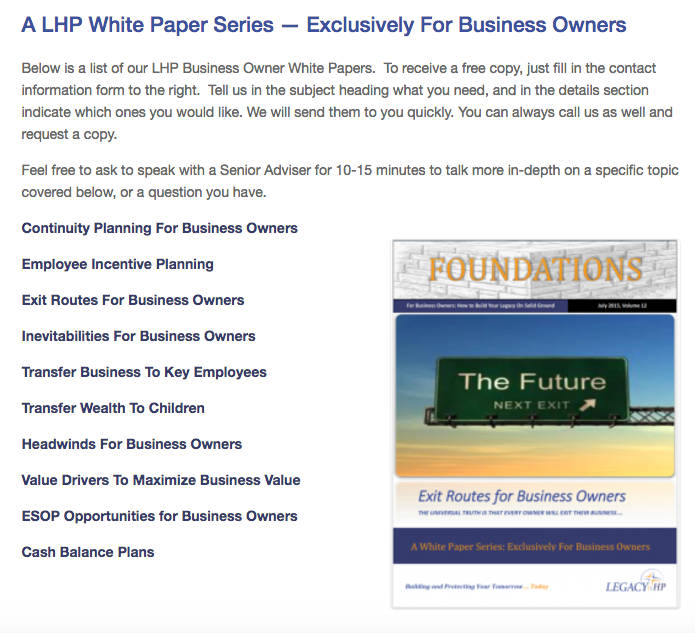Did you ever wonder why one business has buyers lined up willing to pay top dollar while another sits on the market for months, or even years? What do buyers look for in a prospective business acquisition?
There are many opinions about what attributes or characteristics buyers seek, but here’s what we know: the characteristics buyers seek must exist before the sale process even begins and it is your job as the owner to create value within your business prior to the sale. We call characteristics that impact value “Value Drivers.”
Walk A Mile In A Buyer’s Shoes
To get an idea of the importance of Value Drivers when preparing to sell your business, it is important to put on the buyer’s shoes for a minute. Let’s look at a hypothetical case study that illustrates how a buyer might compare two similar companies with a different emphasis on value drivers.
The A Factor Company has EBITDA (Earnings Before Interest, Taxes, Depreciation and Amortization) of $2 million, an owner who runs the business and the systems and processes that create growth. The A Factor Company doesn’t have a real management team in place and the owner generates a majority of its sales. The owner is the center point of the company, holding both the CEO and CFO positions. With this level of responsibility, the owner is burning out quickly.
In comparison, The B Factor Company also has EBITDA of $2 million and a solid management team that runs the business, systems and processes. The management team creates efficiencies within the business and the owner vacations for six weeks a year.
If you were a buyer comparing these two companies, which would provide a more attractive business opportunity? How much more would you pay for a business with a strong management team (one of the most important Value Drivers)? Would you even be interested in buying a business whose management team (the owner) walks out when you walk in?
Investment bankers understand that companies that lack strong value drivers also lack a bevy of buyers. Those buyers that do come to the table do not arrive with pockets full of cash.
Let’s look at several of the more important Value Drivers common to all industries:
- A stable and motivated management team. If you can wait a year to sell your business, we suggest that you consider an incentive compensation system, cash or stock-based, that rewards key employees as the company performs (usually measured by increases in pretax income). Sophisticated buyers know that with a solid management team in place, prospects are good for continued business success. Without a strong management team, it may be very difficult to sell your business to a third party or transfer it to an insider.
- Operating systems that improve sustainability of cash flows. Operating systems include the computerized and manual procedures used in the business to generate its revenue and control expenses, (i.e. create cash flow), as well as the methods used to track how customers are identified and how products or services are delivered. The establishment and documentation of standard business procedures and systems demonstrate to a buyer that the business can be maintained profitably after the sale.
- A solid, diversified customer base. Buyers typically look for a customer base in which no single client accounts for more than 10 percent of total sales. A diversified customer base helps insulate a company from the loss of any single customer. If the majority of your customer base is made up of only one or two good customers, consider reinvesting your profits into additional capacity that will make developing a broader customer base possible.
- A realistic growth strategy. Buyers tend to pay premium prices for companies with realistic strategies for growth. Even if you expect to retire tomorrow, it makes sense to have a written plan describing future growth and how that growth will be achieved based on industry dynamics, increased demand for the company’s products, new product lines, market plans, growth through acquisition, and expansion through augmenting territory, product lines, manufacturing capacity, etc. It is this detailed growth plan, properly communicated, that helps to attract buyers.
- Effective financial controls. Financial controls are not only a critical element of business management, but they also safeguard a company’s assets. Effective financial controls support the claim that a company is consistently profitable. The best way to document that your company has effective financial controls and that its historical financial statements are correct is through a certified audit or perhaps a verified financial statement by an established CPA firm.
- Stable and improving cash flow. Ultimately, all Value Drivers contribute to stable and predictable cash flow. It is important, especially in the year or so preceding the sale of the business, that cash flow be substantial and on an upswing. You can begin increasing cash flow today by simply focusing on ways to operate your business more efficiently by increasing productivity and decreasing costs.
You can install these Value Drivers and better position your company to secure a premium price upon your exit with the help of a trained Exit Planning Advisor.
In future Exit Planning Review™ articles, we will look at the most common Value Drivers in more detail.
If you have any questions about increasing the value of your business prior to your exit, please contact us to discuss your particular situation. We can help you identify and strengthen the current Value Drivers in your business, install additional Value Drivers, and create a roadmap to meet your overall exit objectives. We also have a White Paper and other materials that explain Value Drivers in more detail. Please contact us for more information.
Take care and have a good day,
Michael
ABOUT LEGACYHP: Our passion is our mission -- To position our clients into a positive, energized, posture -- within your businesses and within your lives -- So that you manage change confidently, take decisive action, and enjoy life's journey Today... while you enjoy building your Legacy for Tomorrow.
Notice: The information contained in this article is general in nature and is not legal, tax or financial advice. For information regarding your particular situation, contact an attorney or a tax or financial advisor. The information in this newsletter is provided with the understanding that it does not render legal, accounting, tax or financial advice. In specific cases, clients should consult their legal, accounting, tax or financial advisor. This article is not intended to give advice or to represent our firm as being qualified to give advice in all areas of professional services. Exit Planning is a discipline that typically requires the collaboration of multiple professional advisors. To the extent that our firm does not have the expertise required on a particular matter, we will always work closely with you to help you gain access to the resources and professional advice that you need.



